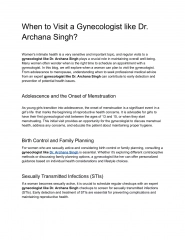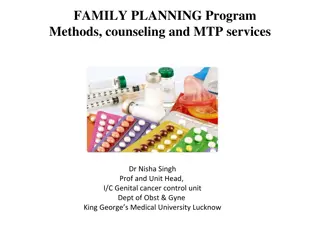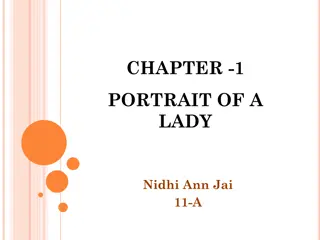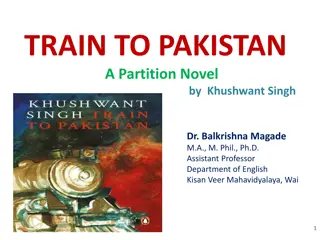The Portrait of a Lady by Khushwant Singh
The Portrait of a Lady by Khushwant Singh delves into the author's relationship with his grandmother over time, portraying the intricacies of human connections within a joint family setting. Through vivid descriptions, the author unravels the evolving character of his grandmother, painting a touching portrait of her daily life and presence. This poignant narrative captures the essence of familial bonds and the profound impact of generational relationships.
Download Presentation

Please find below an Image/Link to download the presentation.
The content on the website is provided AS IS for your information and personal use only. It may not be sold, licensed, or shared on other websites without obtaining consent from the author. Download presentation by click this link. If you encounter any issues during the download, it is possible that the publisher has removed the file from their server.
E N D
Presentation Transcript
The Portrait of a Lady By Khushwant Singh
About the Author: Khushwant Singh was an Indian writer and journalist (1915 2014). He was born in a prosperous Sikh family and spent his childhood in Hadali and Delhi, where his father and grandfather were involved in building construction. After he graduated (1934) from Government College, Lahore (now in Pakistan), he studied law at King s College, London (L.L.B., 1938), and at London s Inner Temple, where in 1938 he qualified as a barrister. He practiced law in Lahore until the partition, when he moved to Delhi with his family, he joined the Indian Foreign Service. Singh began writing short fiction while serving in diplomatic posts in London and Ottawa; his first story collection, The Mark of Vishnu, and Other Stories, was published in London in 1950. Singh s literary output included such nonfiction books as The Sikhs (1953), He served as editor of the Illustrated Weekly of India newspaper Hindustan Times (1980 83). He held a seat (1980 86) in the Rajya Sabha (upper house of the parliament). Singh was later conferred with the Padma Vibhushan in 2007. (1969 78) and of the daily
Vocabulary Mantelpiece- a structure of wood, marble, or stone above and around a fireplace. Revolting unpleasant Absurd Illogical Criss- cross - a pattern of intersecting straight lines Hobbled walked in an awkward way Stoop bend one s body forward Rosary- a string of beads for keeping count of number of chants made of a religious prayer Locks- hair Untidily - not neat Puckered a face contract into wrinkles Serenity the state of being peaceful and calm An expanse of pure white serenity - refers to the calm, relaxed and peaceful character of the author s grandmother
Vocabulary Lewd Association Indecent or Obscene Harlots Prostitutes Gentlefolk - People of noble birth A veritable bedlam of chirruping - refers to the noise and confusion caused by the chirruping of the sparrows Frivolous not having any serious purpose, light-hearted Rebuke - disapproval of something or someone frivolous rebukes - light hearted scolding Sagging sinking downwards Dilapidated in a state of despair or ruin Omitted - leave out or exclude something Crude in a natural state, roughly made Blaze - a very large burning fire Shroud a piece of cloth used to wrap a dead person
Introduction The Portrait of a Lady gives us a picture of human relationship in a joint family. It is a realistic account of how the grandparents give all their time, attention and love to their grandchildren. In this lesson, the author describes his relationship with his grandmother over the years. He pens down her daily activities and how she evolved as a character as time passed by. He explains her appearance which helps create an image in the reader s mind. In other words, the story is the loving tribute from a grandson to a grandmother.
Gist 1. Life of the author in village with his Grandmother: The grandmother was an old woman with a wrinkled face. The author had always seen her like this, for the past twenty years. She appeared to be so old that he could not imagine her being young and pretty , someone who had a husband. She was short, fat and slightly bent. The author had seen his grandfather s portrait- an old man with a turban and a long white beard covering his chest. To the author, his grandfather didn t seem like a man who could have a wife and children, but someone who could have lots of grandchildren. His grandmother used to move around the house in Spotless White with her one hand resting on her waist and her other hand counting the beads of her rosary.
Authors early days in village with his Grandmother: In the initial days, the author and his grandmother had a good relationship. She used to wake him up and get him ready for school. She used to pack the things required by him for the day and accompanied him to school everyday. She used to visit the temple that was attached to the school. She had a routine of reading the scriptures. The author along with other children sat on the verandah singing alphabets and morning prayers. They both used to come back home together with stray dogs roaming around them as his grandmother would carry the stale chapattis to feed them.
Turning point in the relationship The parents of the author settled in the city and called them. As they reached, his relationship with his grandmother took a turn. Though they shared the room, there bond grew apart. He started going to an English medium school, she no longer accompanied him to his school. She, however, used to ask him about his day and what he had learned. She didn t understand the subjects that were taught in the school and also she could help him. She didn t approve of the new syllabus, especially the music lesson which was being imparted to the child. She thought that they did not teach him about God and the scriptures. They saw less of each other.
Activities of the Grandmother when the author studied in university: As the days passed, he grew older and soon went to the university. He had his own room and this made their relationship sour. She stopped talking to everyone and spent her whole day sitting at her spinning wheel, reciting prayers and moving beads of the rosary with one hand. However, in afternoon she loved feeding sparrows in the verandah. Breaking bread into pieces and feeding to the birds was he happiest half an hour of her day. The birds would sit on her legs, her head, some even on the shoulders.
Author went abroad The author decided to go abroad for further studies. She came to the railway station to leave him off. She was not sentimental, continuously recited her prayers, her mind lost in the prayers, and she kissed him on the forehead. After five years, as he returned home, she was there, came to pick him at the station, was still the same as she had been five years ago. She clasped him within her arms and didn t say a word. When they came back home she still used to feed the sparrows.
Last phase of the Grandmother One day, she didn t recite her prayers but instead collected the women of the neighbourhood, got a drum and started singing. The next morning, she was ill with mild fever. The doctor said that there was nothing to worry about but she was sure that her end was near. She didn t want to waste her time talking to anyone in the family anymore but spend her last hours in reciting her prayers laying on the bed. She died and so her body lay on the bed, lifeless. As they prepared for her funeral, they saw all the sparrows sitting in the verandah around her, mourning her death.
Useful Links https://youtu.be/Ty8kgJnX7FY https://www.youtube.com/watch?v=_eQQT4AbOLw https://www.youtube.com/watch?v=h5j4Ibp98BI



























